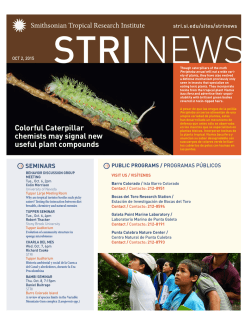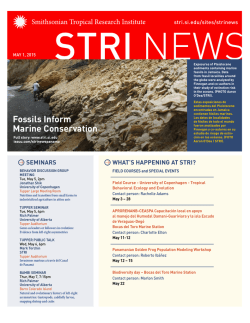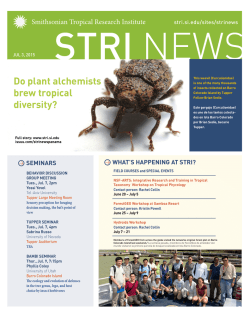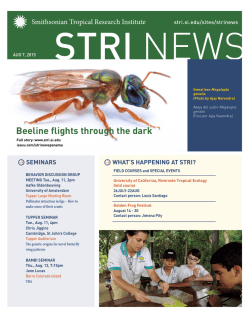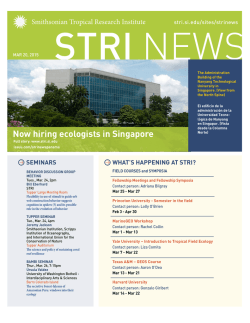
We are entering a “Golden Age” of Animal Tracking
stri.si.edu/sites/strinews JUN 12, 2015 We are entering a “Golden Age” of Animal Tracking The Smithsonian Continues to Convene Animal Movement Researchers Full story: www.stri.si.edu issuu.com/strinewspanama SEMINARS TUPPER SEMINAR Tue., Jun. 16, 4pm Oris Rodriguez Royal Holloway, University of London Tupper Auditorium Miocene fossil woods from Panama and their palaeoenvironmental implications BAMBI SEMINAR Thur., Jun. 18, 7:15pm Jenalle Eck Ohio State University Barro Colorado Island TBA Visiting scientists from the Max Planck Institute of Ornithology used the Automated Radio Telemetry System on Barro Colorado Island in Panama to monitor sleep in wild sloths as they moved through the forest (Photo by Niels Rattenborg, Max Planck Institute for Ornithology) Científicos visitantes del Max Planck Institute of Ornithology utilizaron un sistema de radio teletrimetría automatizada para monitorear el sueño de los perezosos a medida que se movían en el bosque de la Isla Barro Colorado en Panamá.(Imagen cortesía de Niels Rattenborg, Max Planck Institute for Ornithology) WHAT’S HAPPENING AT STRI? FIELD COURSES and SPECIAL EVENTS Field Course - University of Vermont Contact person: Laura May-Collado June 1 - 15 Field Course - Arizona State University Contact person: Nico Franz June 6 – 26 NSF-ARTS: Integrative Research and Training in Tropical Taxonomy Workshop on Tropical Phycology Contact person: Rachel Collin June 20 – 5 ForestGEO Workshop Contact person: Kristin Powell June 25 – July 9 Yale School of Forestry, 2015 Field Course at Agua Salud. BOOK PRESENTATION / PRESENTACIÓN DE LIBRO On June 6 and 7th STRI presented a small exhibit Los días 6 y 7 de junio, en Albrook Mall, pasillo del called “Fossils tell the story” to celebrate the publica- Koala realizamos la exhibición “Los fósiles nos cuentan tion of , written by STRI research technician Félix la historia” con la presentación del libro Historia Natu- Rodriguez and staff scientist Aaron O’Dea. ral del Istmo de Panamá escrito por Félix Rodriguez y Aaron O’Dea. Chapter authors, including Félix, Aaron, Maritza Moya and Tony Coates were on hand to sign a num- ber of free copies of the book, which is also on sale at ellos Félix, Aaron, Maritza Moya y Tony Coates estuvi- Hombre de La Mancha and at the STRI bookstore at eron presentes para autografiar ejemplares . Los libros the Tupper Center in Ancon. están la venta en Hombre de La Mancha y en la librería de STRI en el Centro Tupper de Ancón. Special thanks to Lina Gonzalez and a very hard Los autores de algunos capítulos del libro, entre working crew who created the exhibit and to the Un agradecimiento especial a Lina González y un guides from Punta Culebra who hosted educational equipo muy trabajador que creó la exhibición y a los activities for young visitors. guías de Punta Culebra que organizaron actividades educativas para los jóvenes visitantes. BAYANO DOCUMENTARY FILM FEST / FESTIVAL DE CINE DOCUMENTAL DEL BAYANO From June 2-6, the Third International Documentary Film Festival was held in Bayano, Panama. Intended primarily for the local audience: indigenous Kuna and Emberá and campesinos, the yearly event is organized by “United to Protect our Watershed,” an initiative of the Upper Bayano Emberá General Congress, the Kuna Mdungandi Regional Organization, the Panama Province Campesino Union and the Platanilla Producers Association. Support for the festival was provided by McGill University, STRI, Cosmovisión and the Margaret A. Cargill Foundation. The documentaries shown are primarily Latin American and Panamanian productions including shorts produced by a group of young Bayano residents. Their instructors included Francisco Laurent, from the Wakiponi group in Canada, Lauliano Martinez and Ivan Jaripio, and Panamanian director Irina Ruiz, from the NGO Acampadoc from Los Santos Province. STRI coordinators for the event included Jorge Ventocilla and Lady Mancilla. Del 2 al 6 de junio 2015, se realizó en la región del Alto Bayano, Provincia de Panamá, el III Festival Internacional de Cine Documental del Bayano. El evento, dirigido principalmente a la población local - indígenas emberá, kuna y campesinos - es organizado por el proyecto “Juntos para Proteger Nuestra Cuenca”, iniciativa del Congreso General Emberá del Alto Bayano, la Organización Regional Kuna de Madungandi, el Congreso Kuna de Madungandi, la Asociación Unión de Campesinos de la Provincia de Panamá y la Asociación de Productores de Platanilla. El Festival contó con apoyo académico, administrativo y financiero la Universidad McGill del Canadá, el Smithsonian, el programa Cosmovisión y la Fundación Margaret A. Cargill. Los documentales son principalmente producciones latinoamericanas y panameñas, incluyendo cortos realizados por jóvenes del Bayano. El grupo de intsructores estuvo conformado por Francisco Laurent, de Wapikoni, Lauliano Martinez e Ivan Jaripio, jóvenes kuna y embera respectivamente, y la cineasta panameña Irina Ruiz, de la ONG Acampadoc de la provincia de Los Santos. LINK TO FILMS / ENLACE A PELÍCULAS http://goo.gl/CDvyGS Photo by Aaron O’Dea JACKSON RECEIVES LIFETIME ACHIEVEMENT AWARD JACKSON RECIBE RECONOCIMIENTO POR TODA SU TRAYECTORIA At their Ocean Awards Gala in Washington, D.C. on June 9, the National Marine Sanctuary Federation honored STRI senior scientist emeritus/Scripps Institution of Oceanography professor emeritus Jeremy Jackson for his contributions to understanding human impacts on the oceans and the ecology and evolution of tropical seas with a Lifetime Achievement Award. Resulting in the publication of more than 150 scientific journal articles and 10 books, Jackson’s career spans the disciplines of ecology, geology, marine biology and paleontology. Based on the idea that each generation tends to view the health of the environment as they know it as its baseline condition, while it continues to degrade through time as a result of human intervention, Jackson became a staunch advocate for marine reserves. En la Gala Ocean Awards en Washington, DC, el 09 de junio, la Federación Nacional de Santuarios Marinos de los EE.UU honró Jeremy Jackson, científico emérito senior del Smithsonian y profesor emérito de la Institución Scripps de Oceanografía por su contribución a la comprensión de los impactos humanos sobre los océanos y la ecología y la evolución de los mares tropicales con un reconocimiento por toda su trayectoria. Con más de 150 artículos publicados en revistas científicas y 10 libros, la carrera de Jackson abarca las disciplinas de la ecología, la geología, la biología marina y la paleontología. Basado en la idea de que cada generación tiende a ver la salud del medio ambiente como la ven en ese momento, como su estado básico, mientras esta continúa degradándose con el tiempo como resultado de la intervención humana. Jackson se convirtió en un firme defensor de las reservas marinas. BIGGEST BEASTS EVER / LAS BESTIAS MÁS GRANDES Photo by Blink Films – http://www.blinkfilmsuk.com Catalina Pimiento and her Megalodon shark fossils from the Gatun Formation in Panama star this month on National Geographic TV’s Top 10 Biggest Beasts Ever. Pimiento is wrapping up her PhD in Biology with a minor in Educational Technology at the University of Florida as part of the National Science Foundation-sponsored Panama PIRE project, a five-year effort to study fossils unearthed during the Panama Canal expansion. Catalina Pimiento y sus fósiles de Megalodón, encontrados en la formación Gatún en Panamá aparecerán este mes en el programa de National Geographic Top 10 Biggest Beasts Ever (el top 10 de las bestias más grandes). Pimiento está terminando su doctorado en biología con un técnico en tecnología de la educación en la Universidad de La Florida como parte del proyecto PIRE Panamá, patrocinado por la Fundación Nacional de las ciencias de los EE.UU, un esfuerzo de 5 años para estudiar los fósiles desenterrados durante los proyectos de expansión del Canal de Panamá. http://natgeotv.com/uk/top-10-biggest-beasts-ever DEPARTURES ARRIVALS Steven Vollmer Northeastern University Evolutionary genetics of reef-building corals on both sides of the Isthmus Bocas Del Toro Grace Davis University of California – Davis Demography and Intergroup Relationships in Cebus capucinus Barro Colorado Island Germán Bayona Corporación Geológica Ares Field Course - Field camp Universidad de los Andes Panama HannahWilson and Gina Zwicky Tulane University Behavioral Ecology of Northern and Wattled Jacana Hybridization – Continuation Gamboa Sofia Gripenberg and Andrew Crump University of Oxford Seed predation by insects in tropical forests: a quantitative food web approach Tupper, Barro Colorado Island Laura Bush Bangor University María Croce Consejo Nacional de Investigaciones Cientificas y Tecnicas (CONICET) Sofie Vranken Ghent University Lynn Cornish St. Francis-Xavier University Marycruz Rojas Universidad de Costa Rica Maycol Madrid Universidad de Panamá William Schmidt University of Louisiana at Lafayette Glenda Hunter Vancouver Island University Karla Pedraza and Laurie McConnico Universidad Autónoma de Baja California Sur Fabio Silva and Talita Pinto Universidade de Sao Paulo Robin Taylor, Wilson Freshwater and Micah Marty University of North Carolina Wilmington Tropical Field Phycology - Marine Algal Diversity of Panama Bocas Del Toro Matthew Larsen To Nairobi, Kenya For meetings at National Museums of Kenya and a meeting with Kenya Wildlife Services Owen Mcmillan To Champaign-Urbana, Illinois To meet with the University of Illinois Institute for Genomic Biology William Wcislo To Washington, DC To receive an award and to make a presentation to showcase research on BioGenomics, among other awardees Catherine Potvin and Jose Monteza To Darien, Panama To present the results of the carbon measurements done last year Patrick Jansen To Drakensberg, South Africa To present a keynote at the 6th International Symposium on Frugivores and Seed Dispersal Jacob Slusser and Saskia Santamaria To Santiago, Veraguas Province, Panama To attend and present at the 1st Sustainable Land Management Forum Harilaos Lessios and Axel Calderon To Coiba, Panama To collect Tripneustes depressus Rachel Collin To Bocas del Toro For the Bocas NSF-ARTS project (Taxonomy training) Carlos Jaramillo To Bogota, Armenia and Bucaramanga, Colombia For field work and to attend the World Palm Symposium 2015 Andres Hernandez and Omar Hernandez To San Lorenzo, Colon For the plant and tree annual census Ben Turner To Green Bay, Wisconsin For fieldwork at the Wabikon 25 ha CTFS plot PUBLICATIONS Aisenberg, A., Barrantes, G. and Eberhard, W. 2015. Postcopulatory Sexual Selection in Two Tropical Orb-weaving Leucauge Spiders. In: Peretti, Alfredo V. and Aisenberg, Anita, Cryptic female choice in arthropods: Patterns, mechanisms and prospects. Germany: Springer, pp.79-108. Dale, S. E., Turner, B. L. and Bardgett, R. D. 2015. Isolating the effects of precipitation, soil conditions, and litter quality on leaf litter decomposition in lowland tropical forests. Plant Soil, doi:10.1007/s11104-0152511-8 Dugas, M. B., Halbrook, S. R., Killius, A. M., del Sol, J. F. and Richards-Zawacki, C. 2015. Colour and Escape Behaviour in Polymorphic Populations of an Aposematic Poison Frog. Ethology, doi:10.1111/ eth.12396 Helbig-Bonitz, M., Ferger, S. W., Böhning-Gaese, K., Tschapka, M., Howell, K. and Kalko, E. K. V. 2015. Bats are Not Birds – Different Responses to Human Landuse on a Tropical Mountain. Biotropica, doi:10.1111/ btp.12221 Jaramillo, C., Moreno, F., Hendy, A. J. W., SanchezVillagra, M. and Marty, D. 2015. Preface: La Guajira, Colombia: a new window into the Cenozoic neotropical biodiversity and the great America biotic interchange. Swiss Journal of Palaeontology, doi:10.1007/s13358-0150075-0 Murria, C., Rugenski, A. T., Whiles, M. R. and Vogler, A. P. 2015. Long-term isolation and endemicity of Neotropical aquatic insects limit the community responses to recent amphibian decline. Diversity and Distributions,: 1-12. doi:10.1111/ddi.12343 Ojalehto, B. and Medin, D. 2015. Emerging Trends in Culture and Concepts. Emerging Trends in the Social and Behavioral Sciences, doi:10.1002/9781118900772. etrds0064 Peay, K. G., Russo, S. E., McGuire, K. L., Lim, Z., Chan, J. P., Tan, S.and Davies, S. J. 2015. Lack of host specificity leads to independent assortment of dipterocarps and ectomycorrhizal fungi across a soil fertility gradient. Ecology Letters, doi:10.1111/ele.12459 Pimiento, C. and Balk, M. A. 2015. Body-size trends of the extinct giant shark Carcharocles megalodon: a deep-time perspective on marine apex predators.Paleobiology, 41(3): 479-490. doi:10.1017/ pab.2015.16 Riehl, C. and Strong, M. J. 2015. Social living without kin discrimination: experimental evidence from a communally breeding bird. Behavioral Ecology and Sociobiology, doi:10.1007/s00265-0151942-9 Robertson, D. R. 2015. Coincidental resemblances among coral reef fishes from different oceans.Coral Reefs, doi:10.1007/s00338-0151309-8 Torchin, M. E., Miura, O. and Hechinger, R. F. 2015. Parasite species richness and intensity of interspecific interactions increase with latitude in two 6 wide-ranging hosts. Ecology, doi:10.1890/15-0518.1 Zhu, Y., Comita, L., Hubbell, S. P. and Ma, K. 2015. Conspecific and phylogenetic density- dependent survival differs across life stages in a tropical forest. Journal of Ecology, doi:10.1111/1365-2745.12414 Wolfe, B.T., Kursar, T.A. 2015. Diverse patterns of stored water use among saplings in seasonally dry tropical forests. Oecologia. doi: 10.1007/s00442015-3329-z Jaramillo, C., Cadena, E. and Herrera, F. 2014. Diversidad fosil en el valle de Cerrejon. In: Baez, Lina and Trujillo, Fernando, Biodiversidad en Cerrejon. Bogota, Colombia: Carbones de Cerrejon, Fundacion Omacha, Fondo para la Accion Ambiental y la Niñez, pp.39-55.
© Copyright 2025
